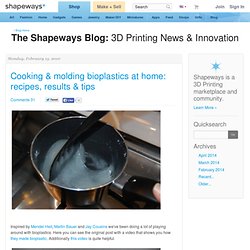

Polylactic acid. Poly(lactic acid) or polylactide (PLA) is a thermoplastic aliphatic polyester derived from renewable resources, such as corn starch (in the United States), tapioca roots, chips or starch (mostly in Asia), or sugarcane (in the rest of the world). In 2010, PLA had the second highest consumption volume of any bioplastic of the world.[3] The name "poly(lactic acid)" does not comply with IUPAC standard nomenclature, and is potentially ambiguous or confusing, because PLA is not a polyacid (polyelectrolyte), but rather a polyester.[4] Production[edit] There are several industrial routes to usable (i.e. high molecular weight) PLA. Two main monomers are used: lactic acid, and the cyclic di-ester, lactide. Gro - starch based bioplastic & natural fiber (cotton) biocomposites. Make your own bioplastic (extended version) Mix it Up ! Now that you have gathered all the necessary materials and ingredients, its time to mix up a batch of potato plastic.

A note to younger viewers: be sure to have a parent with you when using the stove, I don't want you to burn down your house because of this instructable! Also, beware of the starch plastic resin when you are pouring it into a mold, it is very hot and will burn you if it gets on your skin, you can never be too cautious with boiling hot substances. Buy Sorbitol benefits uses UK. Green Plastics: the new science of bioplastic. Shapeways. Inspired by Mendel Heit, Martin Bauer and Jay Cousins we've been doing a lot of playing around with bioplastics.

Here you can see the original post with a video that shows you how they made bioplastic. Additionally this video is quite helpful. So why have I been spending every minute of my free time cooking bioplastic? Moldable Plastic » Purchase.